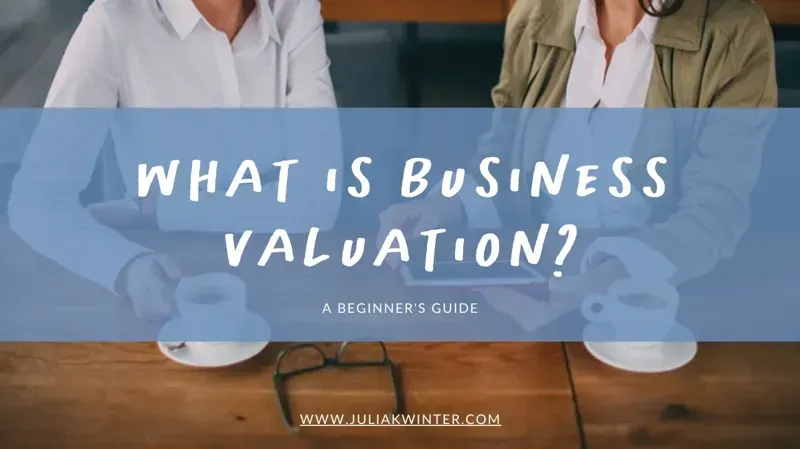
What Is Business Valuation Exactly? Here's a Beginner's Guide
Table of Contents
Why do you need to know the fair market value of a business?
When do you need a business valuation?
What's involved in the valuation process?
How much do company valuations cost?
Finding a valuation professional
What are the common valuation methods?
Determining if a company is under or overvalued
How do you value a pre-revenue startup with no history of operations?
What are common mistakes when valuing a business?
Business valuation definition
The valuation of a business involves an assessment of a company's financial and business assets, liabilities and operations. The business valuation process consists of collecting and analyzing data from various sources and metrics. The objective is to estimate the intrinsic value of a company.
A valuation can be determined through various intrinsic valuation methods, but it can also be determined using the selling prices of similar assets or businesses in the same industry.
In many situations, owners can turn to business valuation specialists to obtain a fair estimate of value, known as fair market value or fair value.
There are various definitions of fair market value (FMV) and fair value. Still, at the core, FMV is the price that would be received to sell an asset or paid to transfer a liability in an orderly transaction (under no compulsion to buy or sell) between market participants.
The present value of future earnings determines a business's worth. The process focuses heavily on the expected future earnings (operating expenses and revenues), business strategies, and risk to determine future income, timeframes, discount rates, and growth rates. Every appraisal is an estimate, and it is imperative to understand the assumptions and data that form the basis of the business valuation.
Why do you need to know the fair market value of a business?
A business valuation appraisal is a crucial step in understanding your company's worth, whether you're planning to sell, seeking investment, or simply want to gauge your business's financial health.
Identifying the true value of a business can help a company's management:
determine a company's share price to make investment decisions
evaluate opportunity costs as they prepare for potential expansion and possible changes
establish a starting point of economic value that can serve as a benchmark as they carry out value creation activities
determine if the business has an optimal capital structure
Knowing the FMV of a business can also assist shareholders in:
splitting the value of a business in a personal or business divorce
setting an entrance price as employees buy into a small business
determining the walk-away price when buying or selling a business
When do you need a business valuation?
Mergers, acquisitions and financing transactions
Business valuations are essential in the negotiation of the sale of a company. When businesses transact, they sell at a price. Price and value are different due to differing negotiating abilities, access to information, the compulsion to buy and sell and the form of consideration given. If an exit strategy is part of your retirement plan, you would want to know the value before entering into a transaction to assess whether the asking price is high or low.
Sometimes creditor lenders require an appraisal in the course of their lending.
A valuation process is necessary to create and update employees' stock owners' plans.
Business valuations are also essential when buying into an existing business as a partner, to ensure a fair buy-in price.
Tax and succession planning
Valuation is used to determine the amount to be paid in estate tax liability and is crucial in retirement planning. Tax and successor valuation follow Internal Revenue Service (IRS) guidelines.
Litigation
Valuations have a significant place in resolving disputes between shareholders and spouses in litigation and divorce proceedings to assist the court in determining legal compensations and matrimonial settlements.
Strategic planning
Business valuation analysis helps identify the drivers for growth and profitable business growth.
Financial reporting
Various accounting rules and standards dictate how a company reports certain transactions and can require a valuation.
How to value a company?
If you want to know the market value of your Disney shares, you can observe the current share price on the stock market.
If a public company's market cap is $50M, the shares can be said to have a value of $50M.
Evaluating private companies is different from public company market capitalisation because we can't observe the share prices for small businesses and private companies.
There are various methods used to value a company, and we will dive into the process, the methods and critical considerations in this article.

What's involved in the valuation process?
The valuation process starts with determining the valuation's purpose and the valuation date. Experts are often retained, and information is gathered from the company's management. The information is analyzed and forms the basis of the valuation conclusion.
In private company valuations, management analyses are generally conducted based on the company's balance sheet strength, financial position, capital structure, historical cash flows, financial metrics, and future earnings prospects. The instruments used to evaluate private businesses may differ between assessors, companies and industries.
How much do company valuations cost?
What's the cost of valuing businesses? A business valuation could cost anywhere between $7,000 and $20,000. Valuation professionals charge based on time spent. If you receive a fee estimate less than that range, you have to assess how much time they propose to spend on your company valuation and whether their "light" approach will provide any valuable insights.
Finding a valuation professional
You've likely learned that not all accountants do taxes. Similarly, not all accountants do business valuations. Chartered Business Valuators and business appraisers are the valuation specialists of the valuation profession.
Business valuation professionals complete a specific designation in addition to their general accounting designations and join one of a few bodies of professionals: Chartered Business Valuators Institute (CBV), American Society of Appraisers (ASA), and the American Institute of CPAs' Accredited Business Valuation Credential Holders (ABV). It's essential to do your market research and ask your trusted accounting advisor for recommendations.

What are the common valuation methods?
Book value
Book value is the share price of the company's stock on the balance sheet statement. You determine the book value by subtracting the total debt from a company's assets. Book value is the starting point for an asset-based approach.
When you calculate the value of a company in this way, you are saying you would buy this business because of the value of the business's assets, not its earnings. The value you calculate using an asset-based approach is called the net asset value or a cost approach.
The book value of a business usually excludes any intangible assets, meaning it is just the value of the tangible assets (cash, accounts receivable, equipment, land etc.) less the value of the business's liabilities.
Sometimes businesses will have intangibles on their balance sheets, but not always - make sure you review the company's financial statements and identify whether there are both tangible and intangible assets. Examples of intangibles that you might find on the financial statements are a brand, customer list, or sometimes it's just labelled "intangibles."
Most investors buy businesses for their income-earning ability, and an income-based method is more appropriate as it often calculates the company's maximum value.
An asset-based approach is appropriate when the business is an investment holding company, when the business's earnings don't generate a sufficient return on the value of the business's assets, and when the business isn't worth more than a liquidation value. The liquidation value of a company is the amount of cash left if all the business assets are sold and the debts are repaid.
No matter which method you determine is the best, you should always use an asset-based approach as one of your methods.
Market capitalization
Market cap is the simplest method for business valuation. The figure is calculated by multiplying the stock price of an organization by the total shares held. But this isn't possible for private companies, so you have to use an alternate method.
Times revenue method
A revenue-based method is a good starting point in a valuation exercise but is rarely (if ever) the best methodology. Generally, a revenue stream generated over a period is multiplied by a number depending on the industry, economic conditions and business-specific risks. The average revenue for tech firms could exceed 3x while service firms could exceed 0.5x. The limitation of a revenue-based method is that it ignores the cost structure of a specific business. Put another way, the business expenses of a small business can be completely ignored in a revenue-based valuation method.
Earnings multiplier
Instead of the revenue method, the earnings multiplier can be used to get a more accurate picture of the real economic value of a company.
An earnings multiplier assumes the business's future earnings will be similar each year. An earnings multiplier method is likely appropriate if the expected future profits are consistent.
The big question with an income-based valuation method is what multiplier to use. You can source multipliers from transactions of comparable companies, somewhat similar businesses, or a build-up method.
Discounted cash flow (DCF) method
The discounted cash flow method closely resembles an earnings multiplier method and is based upon the projections of future cash flow adjusted to determine the present value.
The most crucial distinction between the DCF valuation method and the profit multipliers is that a DCF can incorporate varying future profits, among other factors. In contrast, an earnings multiplier method assumes consistent future profits. If the expected future cash flows are NOT consistent, a DCF business valuation method is likely the most appropriate.
A discounted cash flow is the most intricate of the methods and, because of the financial modelling required, is ripe for errors. In my nearly 20-year career, I rarely have, if ever, seen a discounted cash flow method prepared by a client that reliably estimated the market value of a business.
We don't all have investment bankers to call up for help, so if you can't prepare a complex financial model in Excel, calculate a discount rate, or determine an appropriate terminal value - hire a corporate finance expert to help.
Market value method
Income and market approaches are the most commonplace of the methods. Market values are a relative measure. In this way, companies are evaluated in the context of their industry peers through multiple comparisons with similar companies. The problem with using relative means is that it is prone to errors.
This method involves applying a multiple to a company's financial metric, such as revenue or earnings. The multiple that is used is derived from a transaction of a similar business.
For instance, an iPhone game maker wants to price its business. Say the latest studies show a number of competitors are being sold for 5 to 10 percent of sales. You would apply 5 to 10 percent to the iPhone game maker's sales to estimate the value.
The tricky thing in using market multiples is finding the information. Ideally, the multiples are derived from exactly comparable companies, but in practice, this is often not possible.
Selecting a method
Some methods are more complicated than others, and different approaches can yield different valuations. The best business valuation methodology is dependent upon many factors, such as the reasons for the need for a valuation.
For example, when you sell a business, you typically want to maximize the price. But in the context of acquiring a business, your bias is a more cautious assessment. The company must determine whether they are asset-heavy, or business services oriented. In the case of companies with significant assets, the net asset value could produce the highest value.
Determining if a company is under or overvalued
To calculate the fair value, you have to do fundamental analyses. Fundamental analysis includes studying internal events and a wide range of financial variables.
Companies are overvalued or undervalued when their market capitalization or venture capital (VC) valuation is either higher or lower than the estimated intrinsic value.
Put another way; companies are overvalued when their price exceeds the value and vice-versa.
The key is to remember that price and value are two different things.

Frequently asked questions
How do you value a pre-revenue startup with no history of operations?
It becomes harder to value startups if they have no revenue or profit data to analyze. In practice, the value of pre-profit businesses can be assessed using many measures, including traction, the value of founders, prototypes and trends in the industry.
Many angel investors and venture capitalists have developed their own startup valuation methods. We take a deeper dive into How to Value a Startup Company with No Revenue in another post, but two of these methods include:
Scorecard Valuation Method
The Scorecard method invented by Angel Investment Partners' Bill Payne is used to assess startup performance against similar companies in different sectors, stages of development and regions within the same sector. Then it begins to find the average valuations for similar startups. Various factors include team, products or technology, competitive environment, sales and marketing, and the need for further funding.
Berkus Method
Angel Investor Dave Berkus created the Berkus Method. This method basically allocates monetary value to risk reduction measures. It assesses a firm's business idea, prototype, business team, strategic relationships, and existing customers or sales.
How do you know if a business has value?
A business typically has value when it generates sustainable profits, has strong market positioning, and operates independently of the owner. However, there are several other key indicators that can signal whether a business has real value beyond just its assets or current revenue.
Want more clarity on evaluating business value? My free guide 4 Ways To Uncover Whether a Business Has Value walks you through a proven process to help you pinpoint what really matters, cutting through the common misconceptions in the market. Get your guide now and take the guesswork out of business valuation.
What are common mistakes when valuing a business?
Business valuation can be complicated because it's part art and part science. Suppose you are attempting to value a company on your own. In that case, you may be too close to the subject matter and overlook something important to theoretical investors, or you may be too remote from the business and not realize the impact of some of your assumptions. Common mistakes when valuing a business include:
Not recognizing that price and value are two different things
Over or under-estimating a company's maintainable earnings before interest, taxes and depreciation (EBITDA)
Overestimating a company's competitive advantage
Underestimating the impact of a departing shareholder
Using an earnings-based methodology when a liquidation value is more appropriate and vice-versa
Not estimating how much net cash the business needs for day-to-day operations

Does the date of a business valuation matter?
Yes. Valuations for financial reports as well as taxation are required. Valuations used in transactions such as mergers or acquisitions must comply with all relevant requirements. The date of a business valuation dictates the data and assumptions that will form the basis of the valuation.
If you value a business with a 2019 valuation date, you are using the financial data and the events and circumstances known at that date.
Often, the parties will use a specific agreed-upon date for the business valuation for divorce proceedings.
A current date valuation date is used to determine the business value for transaction purposes.
The bottom line
Business valuations have become complicated because there are so many moving parts and conflicting pieces of information to juggle in evaluating a company's worth. Overall, the most accurate assessment of your business will likely result from the combination of different approaches in business valuation.
The best way to do business valuations would be to hire an expert appraiser or business valuator, like a Chartered Business Valuator, as discussed above, who can provide the most thorough assessment.
Business valuations have become complicated because there are so many moving parts and conflicting pieces of information to juggle in evaluating a company's worth. Want to get started with a rough estimate? Try our free business valuation calculator to get an initial range for your company's value.

Overall, the most accurate assessment of your business will likely result from the combination of different approaches in business valuation.
The second-best way to do a business valuation is to follow The Valuation Formula, the one formula you need and the insider strategies to negotiate the best price for your business. You can learn about The Valuation Formula in my free Masterclass: How to Value a Business and Negotiate the Best Price...Without Complex Excel Models, a Degree in Finance or Access to an Investment Banker.
© 2022 Julia Kwinter. All Rights Reserved.


